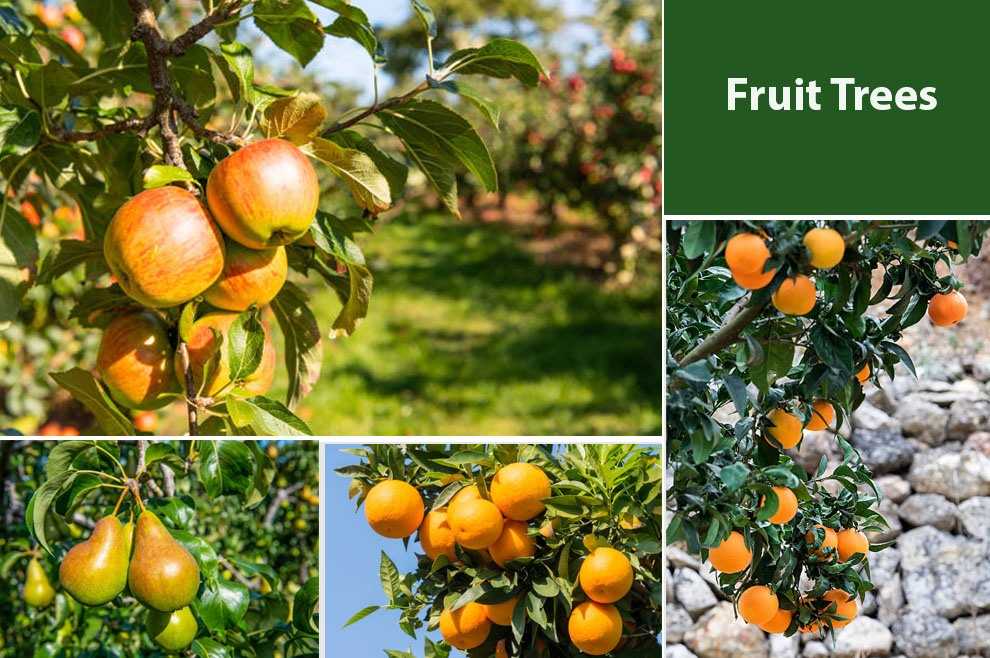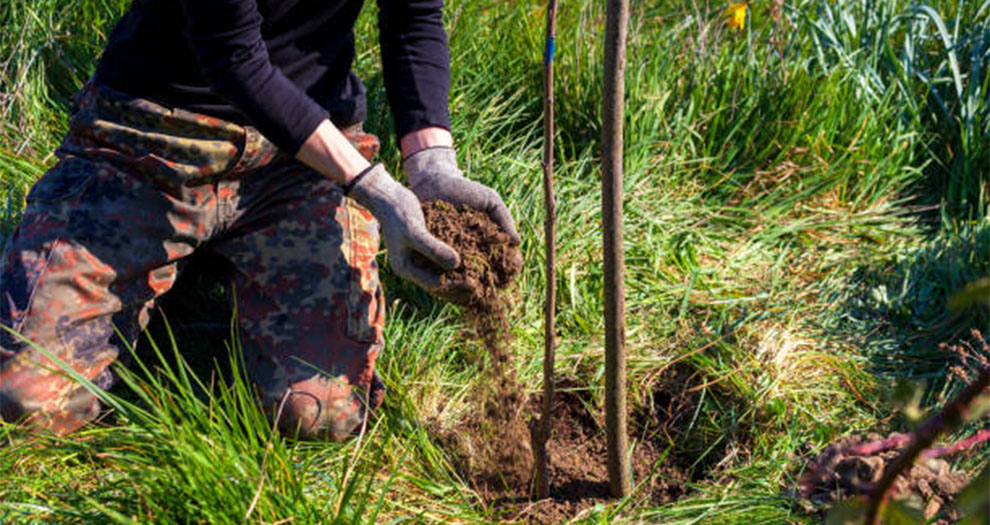What Month To Plant Fruit Trees For Best Results?
Planting fruit trees depends on climate and region. Generally, spring is optimal in temperate areas, while milder climates may allow for fall or winter planting. Summer planting is not so common but can be done with utmost care.

In the world of gardening, there’s a fundamental truth: timing is everything. When it comes to planting fruit trees, understanding the precise moment to dig that first hole is not just a matter of chance—it’s a craft that requires finesse.
Welcome to our guide, “When to Plant Fruit Trees,” where we delve into the delicate balance of seasons, climate, and readiness that makes all the difference in nurturing a thriving orchard.
The local climate, soil conditions, and your chosen fruit tree species all play their part in planting fruit trees correctly.
Whether you’re contemplating the fresh beginnings of spring, the sun-drenched days of summer, the transformative hues of autumn, or even the quiet dormancy of winter, we will guide you toward the best month to plant fruit trees for a fruitful, flourishing orchard.
Spring is often considered the ideal time to plant fruit trees in many regions. In regions with mild winters, planting fruit trees in the fall can also work well. Planting fruit trees during the hot summer months and extremely cold winters is, however, never recommended.
Planting the Right Fruit Trees

When it comes to growing fruit trees, you must consider the following points:
A. Climate and Tree Selection
Selecting the right fruit trees for your region’s climate is paramount to their success. Different fruit tree varieties thrive in specific climate zones. And what month do you plant fruit trees also mold their future.
For example, apple and cherry trees flourish in temperate climates, while citrus trees thrive in warmer, Mediterranean-like regions. Understanding your local climate and the fruit tree’s temperature requirements is the first step.
Moreover, consider microclimates within your garden. South-facing slopes may provide a warmer environment, making them suitable for certain fruit trees.
Conversely, low-lying areas might be prone to frost, requiring more cold-hardy tree varieties. Research and consult local gardening resources to identify the fruit trees best suited to your climate and microclimates.
B. Soil Conditions and Tree Compatibility
The quality and composition of your soil play a pivotal role in fruit tree health. Conduct a soil test to determine its pH, nutrient content, and drainage capacity. Different fruit trees have varying soil preferences, so choose species that match your soil type.
Rootstock selection is equally vital. Rootstocks influence tree size, disease resistance, and adaptation to soil conditions. Research rootstock options to ensure compatibility with your soil and desired tree size.
Additionally, consider interplanting compatible fruit trees and companion plants. Certain plants can enhance soil fertility, attract beneficial insects, or deter pests, creating a healthier environment for your fruit trees.
Related: Best fruit tree fertilizers
C. Local Varieties vs. Exotic Choices
While exotic fruit trees may seem tempting, don’t overlook the charm of local varieties. Indigenous fruit trees are often well-suited to your region’s conditions, requiring less maintenance and resources.
They may also have historical or cultural significance.
Exotic fruit trees, on the other hand, can introduce exciting flavors and diversity to your orchard.
However, they may demand more attention and resources to adapt to your local conditions. Before choosing exotic varieties, research their adaptability and whether they require specific care.
When To Plant Fruit Trees?
The timing for planting fruit trees depends on your climate and location. In temperate regions, spring is often ideal, allowing trees to establish roots before summer heat.
However, milder climates may permit fall or even winter planting when temperatures are cooler. Summer planting is possible with diligent watering.
It’s crucial to choose the right time for your specific area, considering factors like frost dates and local weather patterns.
Additionally, select fruit tree varieties adapted to your region’s conditions to maximize their chances of thriving and producing a bountiful harvest.
Consulting with local gardening experts or extension services can provide valuable insights for your specific location.
Let’s check out the pros & cons of planting fruit trees in each season and which variety of fruit trees should be planted when.
A. Spring Planting Fruit Trees
Which Fruit Trees Should Be Planted in Spring?
Many fruit trees are suitable for spring planting. Common choices include:
- Apple Trees
- Pear Trees
- Cherry Trees
- Peach Trees
- Plum Trees
- Apricot Trees
Why is Spring the ideal time to plant fruit trees: Spring is a favored season for planting fruit trees in many regions. As temperatures begin to rise and the threat of frost subsides, fruit trees wake from their winter dormancy.
The advantages of spring planting are abundant. Warmer soil promotes root growth, and ample sunshine encourages the development of strong branches and leaves.
Advantages of Spring planting:
- Optimal Growth: Spring’s mild temperatures and increasing daylight hours provide an ideal environment for root establishment and early growth. Trees planted in spring have a head start in adapting to their new surroundings.
- Reduced Stress: Planting before the scorching heat of summer minimizes stress on newly planted trees. They have time to acclimatize gradually, reducing the risk of transplant shock.
- Favorable Weather: Spring often brings regular rainfall, reducing the need for excessive irrigation, a key factor in root development.
- Early Fruit Production: Planting in spring can accelerate the time it takes for fruit trees to bear their first harvest, particularly for varieties that fruit within a year or two.
Steps for Successful Spring Planting
1. Choose Healthy Trees: Select high-quality nursery stock with well-developed roots and disease-free branches.
2. Dig Proper Holes: Plant your trees at the appropriate depth and width, ensuring the root collar (where the roots meet the trunk) is level with the soil surface.
3. Mulch and Water: Apply a layer of mulch around the base of the tree to retain moisture and suppress weeds. Water thoroughly after planting.
4. Stake if Necessary: Young trees may require stakes for support. Be sure to secure them without damaging the tree.
5. Prune Sparingly: Lightly prune to remove damaged or crossing branches, but avoid heavy pruning at planting time.
B. Summer Planting for Fruit Trees – Yes or No?
If you’re confused about ‘when to plant fruit trees,’ know that summer planting is not suggested in most cases.
Which Fruit Trees Should Be Planted in Summer?
While summer planting is challenging, it’s possible for heat-tolerant fruit trees like figs, pomegranates, and some citrus varieties. Select varieties adapted to your region’s summer conditions for better success.
Pros and Cons of Summer Planting
Pros:
- Immediate Growth: Summer planting takes advantage of warm temperatures, promoting rapid initial growth.
- Availability: Nurseries often have a wide selection of fruit trees in the summer, offering diverse choices.
- Harvest Timing: Summer planting can align with your desire for earlier fruit production in the following seasons.
Cons:
- Heat Stress: High summer temperatures can stress newly planted trees, leading to transplant shock.
- Water Demands: Summer-planted trees require vigilant watering to combat the heat and prevent dehydration.
- Pest Pressure: Insects and diseases may be more active during the summer, posing a threat to vulnerable young trees.
Care and Watering During Hot Months
Summer-planted fruit trees demand extra care. Adequate watering is crucial to keep the soil consistently moist, especially during heatwaves.
Mulch helps retain soil moisture and regulates soil temperature. Shade cloth or tree guards can provide protection against intense sunlight.
Tips for Successful Summer Planting
- Choose Early Summer: Opt for early summer planting to allow trees to acclimate before extreme heat sets in.
- Hydration Schedule: Develop a consistent watering schedule, ideally during cooler morning hours.
- Pruning: Limit pruning to reduce stress on the tree and retain shade for the trunk.
Fall Planting Fruit Trees
So, if you are searching what is the best month to plant fruit trees, understand that spring or fall is the answer.
Which Fruit Trees Should Be Planted in Fall?
Fall is ideal for planting most fruit trees, including apples, pears, cherries, and plums. These trees benefit from fall planting as it aligns with their natural growth patterns.
Benefits of Fall Planting
- Cooler Temperatures: Fall’s milder temperatures reduce stress on newly planted trees.
- Root Growth: Roots can establish before winter, preparing the tree for spring growth.
- Reduced Watering: Fall rainfall often reduces the need for frequent watering.
Preparing Trees for Winter
Mulching and proper watering are essential for fall-planted trees. Pruning may be necessary to remove damaged or overgrown branches, enhancing the tree’s overall health.
Steps for Effective Fall Planting
- Timing: Aim for early fall planting to ensure sufficient time for root development.
- Deep Watering: Provide deep watering to prepare the tree for winter dormancy.
- Mulch: Apply a thick layer of mulch to protect roots from freezing temperatures.
Winter Planting
Which Fruit Trees Should Be Planted in Winter?
Winter planting is best suited for exceptionally cold-hardy fruit varieties like certain apple and pear cultivars, as well as nut trees like almonds and walnuts. Ensure these trees are well-suited to your local climate.
Special Considerations for Cold Weather
- Frozen Ground: Winter planting requires planning for potentially frozen or waterlogged soil.
- Root Protection: Insulating the root zone helps prevent cold damage.
Protecting Trees from Frost and Snow
Shielding young trees from frost and snow is crucial during winter planting. Wrapping the trunk and applying a layer of mulch can offer protection.
Proper Techniques for Winter Planting
- Choose Hardy Varieties: Select cold-hardy fruit trees suitable for your region.
- Avoid Frozen Ground: Plant on days when the ground is thawed, if possible.
- Root Protection: Insulate roots with mulch and consider using tree guards.
